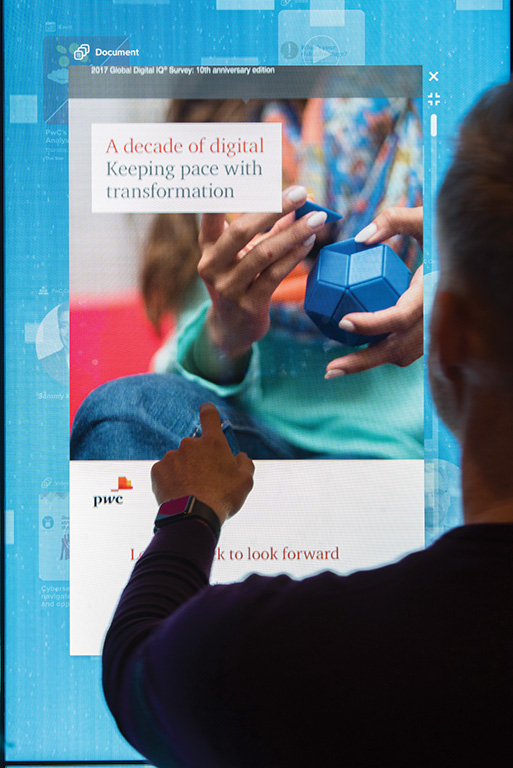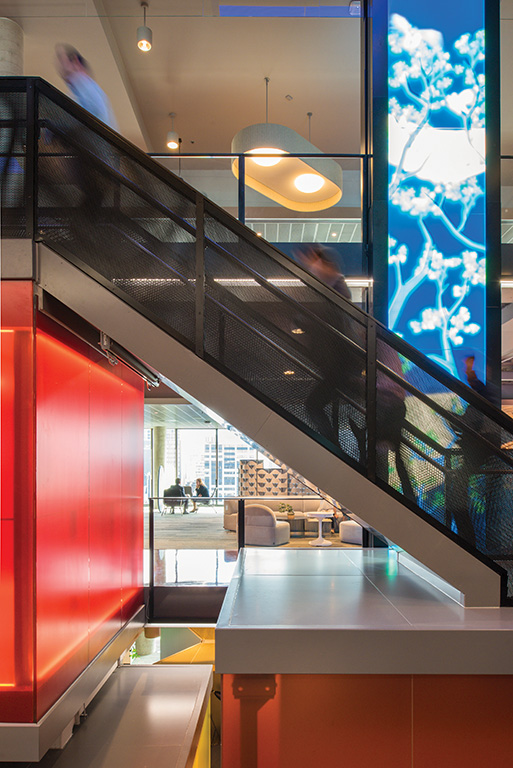
PwC pushes the design and technology boats out to meet clients in a whole new way.
Story: Christopher Holder
Photography: Nicole England
It’s awe inspiring to see digital signage at the vanguard of business transformation.
PwC is a multinational giant of the professional services world. Three of its leases in Australia (Brisbane, Sydney and Melbourne) were up for renewal within some six months of each other and the company decided to grasp the nettle — to throw away the commercial office fitout rulebook and design new spaces that would allow it to meet with its clients in an entirely new way.
The result? Open plan client collaboration floors that are more like hotel lobbies than meeting rooms, and weaved throughout the design is digital.
This issue we take a journey through the Melbourne and Sydney client collaboration floors, and get a sense of why the ‘PwC way’ is being closely scrutinised by the business community around the world.
PwC CIO, Hilda Clune, who helped mastermind the change, told DigitalSignage: “PwC’s purpose is to solve important problems and build trust in society. There is an emerging need for spaces that are flexible and can be used for sessions with clients, where we co-create a solution to a business problem. This scenario needs richness and choice of high-tech, low-tech and tactile tools to support design thinking and accelerated solution design.”
Sounds intriguing! Let’s dig in and investigate some of these tools.

BRAVE
Leading the design charge was interior architects FutureSpace.
We spoke to FutureSpace Managing Director, Angela Ferguson. Angela heaps praise on PwC and Hilda Clune for their bravery in taking a huge leap of faith.
Angela Ferguson: PwC’s brief was to create an exception end-to-end client experience — triggering different expectations and changing perceptions. It was all about options and their clients’ choice in the way they want to work. PwC were really open to new ideas — they actively sought this. We had a huge amount of scope and they were willing to take a big leap of faith. It’s a seriously radical departure from anything done before.
BRAND
PwC’s central pillars of the digital transformation are: Inspiration, Personalisation and Collaboration.
The PwC brand promise is ‘solving important problems and building trust’ and the digital aspects of the design dovetail with the architecture and the interior design.
From an interior design perspective FutureSpace pursued the ‘hospitality-led’ model to its logical conclusion, delivering a range of spaces that break down the traditional barriers of formality, allowing PwC and clients to meet and collaborate.
Angela Ferguson: It doesn’t look like an office. It’s more like a blend of a hotel, hospitality, retail, and even the airline industry. Secondly, it’s more open than any workspace you’ve ever seen before. There’s a whole range of different settings across the client collaboration floors that offer different degrees of privacy and different types of technology. So whatever manner of meeting you could possibly think of, there’s a space that will support you to do that.

INSPIRATION
A floor-to-ceiling digital Waterfall runs through all four floors of the fitout. It’s an architectural installation that shows PwC’s thought leadership, insight and best practice running through the core of the building.
As a PwC client the Waterfall recognises you and will reveal an avatar of you on screen, the content running on the screen will disappear and be replaced by content that you have in your PwC profile.
You can select content (white papers, PwC authored opinion pieces etc) on the touch-enabled Waterfall. It’s a visual representation of how you can harness PwC’s insights and thought leadership.
The Hub Theatre in Melbourne is another example of Inspiration. A large gold-enclosed circular interactive space that showcases PwC’s forward thinking and unique perspective.
Thanks to video conferencing, a partner from PwC anywhere in the world can contribute or even drive the presentation remotely. It’s an immersive, high-end experience; a space where the PwC team can present to key clients, government officials or pitch for new business. There’s an inspiring sense of theatre about the space.

PERSONALISATION
Collaboration works best where there’s trust and intimacy. In other words, PwC understands the importance of getting to know its clients.
The Welcome Wall acknowledges arriving clients personally. For example, if a client arrives for a day of seminars, the Welcome Wall does away with the typical trestle table of name tags. The client approached the Welcome Wall and checks into the event, whereupon the agenda will be displayed, a notification will be sent to the meeting host, catering will be notified with your coffee preference and any dietary requirements. All this is linked into the CMS.
It’s an intelligent approach that’s refined the more the client spends in the space. It goes some way to ensuring a more streamlined experience. The level of hospitality is more akin to what you might hope to experience in a high-end resort or luxe hotel.

THE POWER OF TOUCH
Just about every display you see pictured is touch enabled. All the working screens are from Samsung with special purpose screens coming from Planar, Multitaction and LG. The level of interactivity, you’d have to say, is unprecedented. PwC CIO, Hilda Clune, elaborates:
Hilda Clune, PwC: “Touch is an important element in engaging our audience and in the adoption of technology. As technology more frequently becomes the tool of choice for innovative and collaborative sessions, increasing the opportunity for touch technology naturally lifts the degree of interaction. In the more sophisticated experiences through the journey, the technology is designed to entice the person to engage in an intuitive way.”
Nick Orsatti, GM of system integrator, Fredon Technology, talks us through some of the other technology decisions: “PwC’s Welcome Wall uses Planar displays with a PQ Labs touch overlay. Multitaction displays are used for the 180° curved innovation hub space in Sydney — the curvature of the displays makes conventional IR touch less suitable.
“The equivalent space in Melbourne is a little larger and we’ve used SiliconCore 1.5mm pixel pitch LED, which represents five contiguous HD images. There’s no touch on those screens; presentation only. That setup and the Multitaction version has tvONE CORIOmaster video wall processing behind it, to allow for the various use cases.
“The team at Corsair Solutions support tvONE well and applied their talents to working on that video wall application. CORIOmaster looks to be well designed for presentation areas like this.”

FLAME TREE
The LED Flame Tree in the Melbourne office is the creation of lighting designer to the stars, Bruce Ramus. The artwork extends through the four floors of the atrium then branches out below like the roots of a tree. Various, largely indigenously-styled, content changes with the Melbourne weather which famously can swing about from hour to hour.
COLLABORATION
Collaboration: here’s where we really get down to business and these are the ‘Client Collaboration’ floors, after all. The spaces are designed to encourage clients and the PwC team to actively work together and create solutions.
The focus is on collaboration rather than the traditional presentation paradigm. To achieve this the digital tools need to be trustworthy and friendly to both staff and client.
Digital content developer, Downstream, has created a bespoke Asset Browser in a number of the collaboration rooms. Running on a 72-inch touch-enabled Samsung display, the interface allows the easy, real-time access of multiple data sources (PDFs, MOV files, browser windows etc).

DIGITAL SOUL SEARCHING
PwC’s harnessing of digital signage signals a real coming of age for the platform. Business understand the importance of the web as an online extension of its brand, and is gradually getting its head around what client-facing smartphone apps are doing to complement that. Now, with digital signage, we can see just what digital can do for a brand in the physical world. Downstream calls it an ecosystem and I can see why. It’s more than funky media, more than impressive hardware, more than fastidiously integrated technology, more than eye-catching slogans, the PwC approach developed with Downstream and FutureSpace (ably brought to life by integrator, Fredon Technology) is far more intimate, integrated and intelligent than that. It’s genuinely transformational.
As one PwC staff member was heard to remark: “it’s like starting a new job. I have the same email address but I have a new job.” Such is the philosophical change embodied by the new work environment.

WHO’S WHO
Interior Architect: FutureSpace
Digital Content & UX: Downstream
AV Consultants: Audio Systems Logic (ASL)
AV Integration: Fredon Technology

